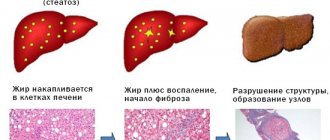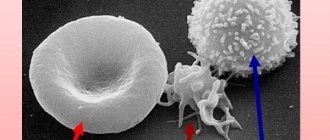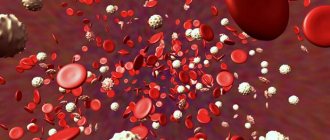The completeness of the state of a woman’s reproductive system is determined by the characteristics of menstruation and the symptoms accompanying them. You should pay attention to the duration of menstruation, the amount of discharge, and its consistency. An important factor is how painful this period is and whether it affects overall well-being. If during menstruation clots similar to liver come out, you need to consult a gynecologist. The range of possible causes of this symptom is wide, and half of them can potentially lead to death.
Causes
There are several types of etiology for large clots that externally resemble the liver. The most common of them are reflected in the table.
| Factor contributing to liver-like clots | Why does it occur | How to remove the factor in question |
| Hormonal imbalance | Stress, inflammatory processes in the organs of the reproductive and/or endocrine system | Through the administration of hormonal agents, the use of sedatives |
| Complications of pregnancy | Increased physical activity, hormonal imbalance, endometrial failure | The woman is indicated for hospitalization in the gynecology department in order to maintain the pregnancy. In the hospital, the patient was recommended to limit physical activity and take vitamin therapy. |
| Neoplasms: fibroids, cysts | Hormonal instability | Surgical elimination or watchful waiting (depending on how severely the tumor disrupts the menstrual cycle) |
| Abnormal uterine structure, changes in the endometrium | Past curettage, problematic childbirth, congenital features of the anatomy of the uterus | Antibiotic therapy, administration of vitamins, hormonal substances, immunomodulators |
| Features of the recovery period after childbirth, abortion | Damage to the inner uterine layer | Antibiotic therapy, administration of hormonal substances, douching with antiseptic solutions |
| Use of an intrauterine device | Incorrectly installed spiral, excessively long use. Also, clots are an individual reaction of the uterus to a contraceptive. | Removing the IUD, selecting a more gentle type of contraception |
| The presence of hidden or obvious diseases in the body | Penetration of pathogenic microflora, hypothermia, exposure to stressful situations. Endocrine system disruption, irregular or, conversely, overly active sex life, poor personal hygiene. | Correction of blood glucose levels, antibiotic therapy, administration of vitamins, immunomodulators |
During puberty
The formation of menstruation takes up to 2.5-3 years. During this time, the dates of their onset, the volume of discharge, shade, and accompanying sensations may change. Adolescence is characterized by hormonal changes and emotional instability. In addition, a new condition is stressful for a girl. Taken together, this can negatively affect the frequency of menstruation and cause it to fail. After a short period of delay, heavy bleeding occurs with the discharge of large parts of the endometrium. Normalization of the cycle in 90% of cases is carried out independently, without the need to consult a doctor.
Complications during pregnancy
The reason for the development is hormonal imbalance, increased physical activity, sexual activity, despite the prohibition by gynecologists. Predisposing factors are exposure to high temperatures, stress, intoxication. The main symptom is the vaginal discharge of large fragments of the endometrium. The resulting incompetence of the inner layer of the uterus contradicts the further full course of pregnancy.
The phenomenon is accompanied by severe pain. In 2 out of 10 cases, a woman’s body temperature rises. If the clots are large, there is a high probability of a decrease in blood pressure. Associated symptoms are pale skin, weakness, decreased performance, dizziness, nausea. If the threat of termination of pregnancy is not prevented immediately, a miscarriage or premature birth occurs (depending on the trimester).
Endometrial pathology
Inflammation of the inner layer of the uterus is a consequence of hypothermia and the penetration of pathogenic microflora. Abortions and problematic births also have an unfavorable effect on the condition of the endometrium. Signs of inflammation of the uterine mucosa:
- Bleeding of varying degrees of intensity, accompanied by the release of areas of the endometrium. Immediately after the evacuation of several large parts of the membrane, increased bleeding occurs. Then the phenomenon slows down and repeats again after massive clots are rejected.
- Pain syndrome at rest, during intimacy.
- Increased body temperature, which is caused by a progressive inflammatory process.
- Dyspeptic disorders (nausea, vomiting, bloating).
- Asthenovegetative disorders - irritability, insomnia, lethargy, weakness, dizziness.
Inflammation of the uterine mucosa can become chronic. The pathology is dangerous for the development of infertility. Endometriosis is the growth of the inner uterine layer beyond the organ. The etiology of the disease has not been fully studied. The condition is accompanied by the same symptoms as endometritis, with the exception of increased body temperature. Increased secretion of large clots resembling liver occurs during menstruation and in the period between them.
Ovarian cysts
Benign neoplasms of the female paired organ develop due to hormonal changes. Cysts manifest themselves as pain, discomfort during intimacy, and menstruation. Neoplasms affect a woman’s libido and her well-being during menstruation. There is a change in hormonal levels, artificially prolonging the luteal phase. After your period is delayed for several days, heavy bleeding is observed. In this case, untimely menstruation indicates a hormonal imbalance. And fragments of the endometrium in menstrual blood indicate the presence of neoplasms.
Anomaly of the uterus
When the anatomical structure of the uterus has peculiarities (it is bicornuate, saddle-shaped or with an uncharacteristic cervix), this is reflected in the course of the menstrual cycle. Menstruation is accompanied by pain, cramps and neurological disorders. Menstrual blood accumulates inside the reproductive organ, since its anatomy serves as an obstacle to the outflow of mass. After a sufficiently large amount of secretion is collected, pushed out by uterine contractions, it is released out. The presence of large fragments indicates rejection of the endometrium during spasms or clotting of menstrual blood during its stagnation inside the uterus.
Myoma
It is a benign neoplasm. Develops in the wall of the uterus under the influence of hormonal imbalance and other unfavorable factors:
- irregular sex life
- undergone curettage (especially numerous)
- sedentary lifestyle and frequent inflammation of the uterus
- endometriosis
The hormonal origin of fibroids has made it possible to establish the so-called risk group for the development of neoplasms. Women are susceptible to tumor formation during pregnancy, after termination of pregnancy, or as a result of menopause. Symptoms of the neoplasm are pain during intimacy, heavy uterine bleeding (up to 2 weeks in a row). Due to uncompensated blood loss, weakness and anemia increase, and blood pressure levels decrease. When the tumor reaches a significant size (in 7 out of 10 cases), it puts pressure on the bladder and rectum, since the uterus is located between them. The consequences of compression are constipation and cystitis, urinary retention, dysuria, pain during defecation.
Adenomyosis
The pathological condition is characterized by the formation of multiple niches in the uterine walls. Gynecologists have not reliably determined the etiology of the disease. Predisposing factors are problematic childbirth and a history of abortion, prolonged infectious processes of the reproductive system. Associated symptoms are pain, heavy bleeding associated not only with the onset of menstruation, cramps, and decreased blood pressure. Clots present in vaginal secretion are formed due to a blood clotting disorder.
The reason for the appearance of discharge with clots
During the first half of the menstrual cycle, a woman’s body prepares for conception and the reception of a fertilized egg. In addition to the development of the follicle, changes occur in the structure of the uterine tissue. The top layer, the endometrium, thickens, thickens, and becomes loose. If conception does not occur, the body understands that there will be no pregnancy, the uterus is freed from unused endometrium. Your period begins.
Rejection of the layer occurs through contraction of the muscles of the uterus. A week before the expected menstruation, a woman feels cramps in the lower abdomen. Gradually, the entire layer of the endometrium comes out with blood discharge during menstruation in clots. This is especially noticeable in the middle of menstruation and in its last days. There is no reason to worry. On the contrary, you should worry if the blood discharge is scanty and there are no clots. This indicates insufficient development of the endometrium, which prevents pregnancy.
Small blood clots with scanty discharge at the beginning of menstruation, on the last day - it’s just coagulated blood. Once in the vaginal environment, it quickly coagulates under the influence of secretory secretions of the genital organ and oxygen. It comes out already curled. Large clots in blood discharge indicate a change in the functioning of the reproductive system. But they can also be within the normal range under certain circumstances.
Other reasons
Factors predisposing to the development of complicated menstruation are excessive physical activity on the eve of it, intimacy, exposure to high temperatures (taking a hot bath or shower). Other possible conditions are intrauterine infection, nervous shock.
After childbirth
Regardless of the type of labor (physiological or surgical - cesarean section), the uterus is restored in the first 7-10 days. The process is characterized by intense rejection of large fragments of the endometrium. Renewal of the mucous layer occurs due to hormonal changes and mechanical damage to it. The size of the clots varies from 5 to 11 cm in diameter. But during this period, the patient is still under the supervision of doctors, therefore, when prerequisites for bleeding appear, the woman receives hemostatic therapy.
Due to curettage of the uterine cavity
With a correctly performed abortion, the uterine cavity is completely freed of the embryo, fertilized egg and placenta. The only physical sensation during the recovery period is a slight nagging soreness in the suprapubic region. Bloody vaginal discharge is observed for no more than 2 days. Menstruation is restored gradually.
Insufficient quality removal of the fertilized egg and placenta causes a number of adverse events:
- Increased body temperature
- Pain syndrome - unpleasant sensation inside the genital tract and above the pubis, aches in the lumbosacral back
- Decrease in blood pressure and accompanying weakness and disability
- Dyspeptic disorders – nausea, vomiting
But, first of all, heavy uterine bleeding occurs. The general masses contain both minor streaks of blood and large fragments of the inner layer of the uterus. The phenomenon is dangerous due to a number of complications - from the development of infertility to sepsis (blood poisoning). The necessary tactic is to immediately go to the hospital and repeat curettage of the cavity of the reproductive organ.
Intrauterine device
A contraceptive placed inside the cervix provides protection against unwanted pregnancy, but can cause a wide range of complications. Among them are pain, cramps, aggravation of the period due to the formation and subsequent rejection of clots. The listed phenomena are caused by the response of the female body to the implantation of a foreign object into the organ.
Poor blood clotting
Blood clotting ability is important to prevent bleeding. But this property of a biological fluid can be influenced by many factors, including hereditary predisposition. The departure of large parts of the mucous membrane that accompanies the period of menstruation indicates problems with blood clotting. Insufficiency or excess of enzymes that contribute to the formation of fragments leads to thickening of menstrual blood. It is released in the form of large mucous particles due to contraction of the female reproductive organ.
Systemic pathologies
Disruption of the endocrine system causes hormonal disorders. Most often, the passage of large clots occurs against the background of thyroid dysfunction or insulin-dependent diabetes mellitus. Correcting the state of the endocrine system allows you to eliminate pain during menstruation and normalize the outflow of blood from the uterus.
Menstruation color
A healthy woman has a deep red hue to the blood released during menstruation. Together with the separated layer of the uterine endometrium, an egg that has not been fertilized also comes out.
Menstrual blood is darker, this is quite easy to explain. Initially, when the mucous layer is separated, small capillaries are damaged, then the blood has a normal color, it darkens when it comes out due to the destruction of hemoglobin cells. Saturated discharge is considered normal and should not cause concern.
The discharge may have a dark brown tint and be clotted in young girls. Gynecologists explain this by an unstable menstrual cycle. This phenomenon should not alarm you, it is considered normal, and as the cycle stabilizes, everything goes away.
Brown menstruation may occur in women taking hormonal medications. The discharge is explained by hormonal instability and different blood clotting. The brown color of the blood may be due to the small amount of oxygen present in the vagina.
You need to see a doctor when there is no normal discharge during menstruation and brown lumps are observed. A woman may feel nauseated, dizzy, and many complain of painful cramps in the abdomen.
You should immediately visit a gynecologist if brown clots appear in the middle of your cycle. It should be remembered that during pregnancy such discharge is also not normal and can cause a miscarriage.
When is a visit to the doctor necessary?
Indications for immediate contact with a specialist:
- menstruation is accompanied by severe pain and increased body temperature
- health does not improve even after taking analgesics
- discharge is characterized by an unpleasant odor
- the patient feels weakness, apathy, difficulty in taking a comfortable, pain-free position
- after the release of several large fragments of the mucous membrane, bleeding intensifies
- the condition lasts more than 7 days in a row
- blood pressure level is reduced due to many days of heavy blood loss
An even more serious argument is the recurrence of the condition, which indicates the presence of a hidden disease. The specialist will determine the root cause of the development of the process and eliminate the possibility of termination of pregnancy and other intrauterine pathologies.
What can clots mean during menstruation?
Having seen unusual discharge, you need to analyze your feelings and state of health. Events in the previous month. Maybe the reason for unusual periods with clots lies in them.
- Hormonal disbalance. One of the most common reasons. Hormonal balance can be disrupted for various reasons. In the absence of other alarming symptoms, nervous disorders are most likely to blame. All processes of the reproductive system are coordinated by the brain and central nervous system. Under its influence, the required amount of hormones is produced at each stage of the menstrual cycle. Stress, depression, nervous tension, and an unfavorable psycho-emotional environment at home and at work disrupt the full functioning of the nervous system. In this situation, menstruation is often delayed for several days, and then blood clots similar to the liver appear. To prevent the situation from repeating itself, you need to pay attention to your psychological well-being and eliminate irritants. In some cases, the situation with clots can be resolved by taking hormonal medications.
- The septum on the cervix. It often occurs during the development of the fetus in the womb. But it can appear during life under the influence of unfavorable factors. Abortion, nervous breakdown, severe stress, smoking, and alcohol abuse contribute to the formation of abnormalities in the genital organ. The septum in the uterus does not allow the discharge to fully exit. They stay inside for some time and manage to curl up. Then pieces that look like meat appear. Menstruation with clots repeats every time. The septum is removed surgically.
- Intrauterine device. The presence of a foreign object in the uterus may be accompanied by a change in the consistency, quantity, and duration of menstruation. Large clots are present due to the same septum. The situation is similar to the previous one. The intrauterine device does not prevent fertilization, but rather prevents the egg from attaching to the walls of the uterus. Therefore, large clots appear - an early miscarriage.
- Abortion. May be accompanied by heavy bleeding and unusual pain in the lower abdomen. Pieces that look like meat are a miscarriage. This situation is always accompanied by a delay of 1–2 weeks, the presence of the first signs of pregnancy. For one reason or another, the egg was unable to attach to the walls of the uterus and a breakdown occurred. In general, there is nothing serious if the discharge is not too heavy and stops within 7 days. In most cases, the situation does not require cleaning the genital organ. But to calm your nerves, you can undergo an ultrasound procedure.
Which doctor should I contact?
Treatment of poor health during menstruation is carried out by a gynecologist. Regardless of the specifics of the medical institution, you do not need to visit a therapist first. During the examination, the gynecologist determines the root cause of the burden of menstruation. The main factor – the profile of the doctor who will carry out the treatment – depends on the diagnostic result and the nature of the identified pathologies. In 90% of clinical cases, patients with complicated periods are treated by a gynecologist.
When this phenomenon is associated with the presence of a benign tumor (fibromyoma), treatment is carried out by an oncologist. If indigestion (diarrhea, constipation) occurs against the background of painful periods, a gastroenterologist is involved in the preparation of therapy. When your health is aggravated by insomnia, irritability, and depressed mood, you need to contact a neurologist. If bloody vaginal discharge is caused by hormonal disorders, the participation of an endocrinologist will be required.
Conservative therapy
Most often, this type of treatment is aimed at restoring a woman’s strength and replenishing the amount of iron in the body caused by blood loss.
Most often treatment includes:
- Taking a vitamin complex, which must necessarily contain folic acid and vitamins A, B, C and E;
- Prescription of hormonal drugs;
- Compliance with the therapeutic and protective regime, which is very important in the presence of juvenile uterine bleeding.
- Taking medications with a high iron content, which are prescribed for low hemoglobin.
https://youtu.be/ch-5E1Dz1Cc
Diagnostics
The examination involves the use of laboratory, hardware and instrumental techniques. The most informative:
- Blood test (clinical, biochemical), general urine test. They help detect the inflammatory and infectious process, hormonal imbalance, and anemia. The determination of blood clotting is valuable.
- Ultrasound of the uterus and appendages.
- Hysteroscopy.
- Laparoscopic examination (in 90% of cases accompanied by a biopsy).
- MRI. The method of complex radiation imaging is used to confirm the presence of a tumor process.
Diagnostic measures are prescribed taking into account the expected type of disorder and the cause of its development.
Treatment
The therapeutic program directly depends on the identified health problem. More often, the disease that causes clots during menstruation is eliminated in a conservative way. Surgery is performed only in cases where drug therapy has not provided a positive result.
Conservative treatment
Endometritis is treated primarily with antibiotic therapy in combination with the administration of vitamins and immunomodulators. Systemic pathologies are eliminated comprehensively - by prescribing anti-inflammatory drugs and hormonal drugs. If curettage of the uterine cavity is not performed well enough, the procedure is repeated. If more than 1 month has passed since the termination of pregnancy, a revision of the reproductive organ is recommended, then hormone therapy. An additional measure is taking broad-spectrum antibiotics. When the presence of an intrauterine device creates problems for the full course of the menstrual cycle, the contraceptive is removed.
To normalize blood clotting ability, anticoagulants (Heparin, Clexane, Flenox, Fraxiparine) are administered. Endocrine problems are eliminated by introducing hormones produced by the pituitary gland, adrenal cortex, and ovaries. To relieve pain, conservative therapy involves the prescription of non-steroidal anti-inflammatory drugs. The treatment program for each of these conditions is supplemented by the need to follow a diet. A woman is not recommended to consume sour, salty, spicy foods, as well as alcohol and coffee.
Surgical treatment
Benign neoplasms of the uterus and appendages are treated mainly surgically. As long as the tumor does not interfere with the menstrual cycle and normal well-being, fibroids are not affected. Unlike endometritis, endometriosis is treated surgically, followed by the use of antibiotics to prevent the infectious process. Cystic neoplasms are treated laparoscopically.
The duration of conservative therapy or recovery after surgery directly depends on the stage of the disease at the time of treatment. Therefore, if the period of menstruation is aggravated by discharge that looks like the liver, you should contact a gynecologist and do not delay the diagnosis.
When danger is too close
Our mentality is such that people do not like to turn to doctors for help. Everyone has their own reason for this. Therefore, girls who suffer from periods with huge clots will not always go looking for the cause of this situation.
But there are cases when ignoring the body’s hints is fraught with serious health problems.
So, when is it worth going to the gynecologist immediately:
- Heavy and prolonged menstruation for more than 7 days;
- Discharge of blood is accompanied by severe pain;
- Menstrual blood has an unpleasant and uncharacteristic odor;
- Menstruation comes out with gray-yellow clots.
In general, it is better not to risk your health.
If you find strange discharge or any abnormalities, it is better to consult a doctor on this issue. And as they say: “the wolves are fed and the sheep are safe.” DID YOU LIKE THE ARTICLE? SHARE WITH YOUR FRIENDS!










